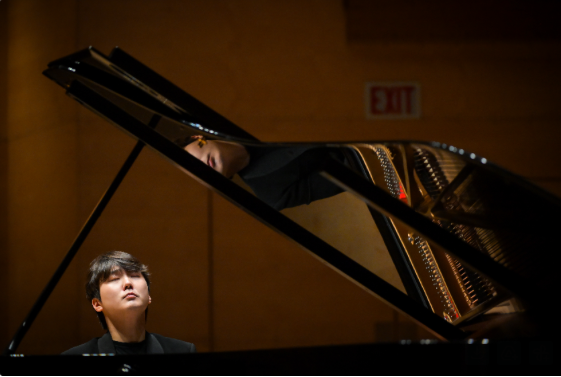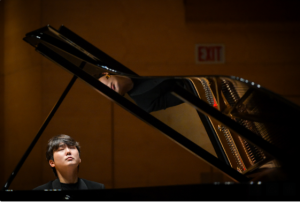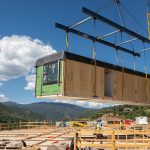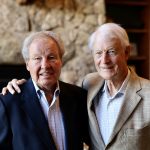Pianist Seong-Jin Cho soars with Ravel in an enthralling marathon

Diego Redel/Courtesy photo
Pianist Seong-Jin Cho has been touring Europe and the United States since January with a marathon evening of Maurice Ravel’s works originally written for solo piano. It’s been getting raves everywhere. The Aspen Music Festival was his last stop.
The recital in Harris Hall on Monday evening had veteran pianists in the audience in awe (and we longtime listeners, as well). At the second intermission of the nearly three-hour concert, Patrick Chamberlain, the vice president for artistic administration who assembles the Aspen Music Festival’s jigsaw puzzle schedule, was grinning uncontrollably.
“Unforgettable, one for the ages,” he said.
In a Facebook post, faculty pianist Anton Nel wrote, “I am over the moon that I was able to hear this.”
Cho, 25, has reached the top tier of pianists of his generation. He took on the unique project to celebrate Ravel’s 150th birthday year. A February performance at Carnegie Hall earned ecstatic reviews, and a recording was issued earlier this year as well. The live performance here was, if anything, even more detailed and dramatic.
The program of 13 pieces began with the composer’s first published effort for solo piano, the brief “Sérénade grotesque” from 1893, when the composer was only 18 years old. It then progressed chronologically through 1917’s “Le Tombeau de Couperin.”
This approach had the bonus of spotlighting Ravel’s own development writing for piano. Conveniently, the two most imposing works — the Maroon Bells of piano music “Miroirs” and “Gaspard de la nuit” — came at the center of the program, bracketed by two short intermissions. Although more than a few attending bailed out after those two monumental works, those of us who stayed could have lapped up even more.
The first grouping revealed how Ravel’s style was fully realized early on, capturing in music a vivid sense of the real, and imagined, world. In Cho’s hands, “Grotesque” growled like a lumbering monster, and the 1895 “Menuet antique” demonstrated how Ravel adopted the form and rhythms of traditional forms but gave melody and harmony his own spin.
“Pavane for a Dead Princess” benefited from Cho’s velvety touch and poise, which let the music float and the finish sink gently. He made the sound of water dance in “Jeux d’eau” — a foreshadowing of Ravel’s return to representing water in later works. In the three-movement Sonatine, he made the menuet into a dreamy pointillist picture, not the fuzzy cloud one usually hears. Rhythm accented the charming finale.
At this point, the pianist proved able to consistently find the colors in Ravel’s ravishing harmonies and glistening decoration, all the while making it feel organic rather than slapped on. There was elegance and clarity, a lightness around the music’s wit, and relish in the advanced (but never grating) harmonies — much of which influenced jazz pianists and composers throughout the twentieth century.
“Mirroirs” — written only a year after Sonatine — produced fluttering figures in “Noctuelles” that felt improvised, yet amazingly accurate. The heaving, swelling sea was palpable in “Une barque sur l’océan.” Most impressively, Cho conjured the essence of flamenco in “Alborado del gracioso” and the distant pealing of bells in “La valée des cloches.”
“Gaspard” reached a pinnacle of technical mastery to create evocative scenes and conjure physical reactions from us listeners. The water in “Ondine” flowed enticingly. The persistent pealing of the repeating pairs of B-flats in “Le gibet” found different colors to distinguish between the two notes, not just one softer than the other. He created a magical eeriness. And in “Scarbo,” the demanding techniques required simply to play all the notes managed to suggest an actual goblin darting around all the pianistic pyrotechnics.
In “Valse nobles et sentimentales” (which Ravel later orchestrated spectacularly), Cho was able to distinguish each short waltz with a different style and rhythm, from a brash opener to the regretfulness of the last one. In “Le tombeau de Couperin,” there was more delicious fluttering in the Prélude, followed by the daintiest imaginable Fugue. As rhythmically fiery as the Toccata finale was, the performance never compromised Ravel’s masterful balances.
The audience, clearly hoping for some sort of encore, persisted through several curtain calls, but what can a pianist add to such a thoroughly complete program? Cho bowed, smiled apologetically, and gently closed the cover to the keyboard.
On Wednesday, the American Brass Quintet’s annual recital mixed its usual cocktail of music from the Renaissance and contemporary works. Of the former, the group’s onetime trumpet player Raymond Mase’s suite “In Gabrieli’s Day” made a tasty appetizer. Best was Gabrieli’s slow-paced, lovely contrapuntal chorale “Sacro tempio d’honor,” but the canzons and other short pieces all were a delight.
Among the newer options, best was Phillip Lasser’s jazzy, brassy, hopeful “Common Heroes, Uncommon Land.” It was also grand to hear a zesty performance of Joan Tower’s evergreen “Copperwave.”
I disliked Tyshawn Sorey’s “Largo,” a music festival co-commission. Curiously inert, it was mostly chords built one note at a time and went nowhere with it.
Thursday’s Wind Orchestra concert turned things around in the music tent — seating the smallish crowd on chairs on risers and the ensemble facing away from the 2,000 empty seats. It created an intimate environment in a cavernous space for a generally delightful program conducted by Joaquin Valdepeñas (also the principal clarinet in the Festival Orchestra).
The centerpiece, Stravinsky’s Octet, got a lively and delightfully rhythmic performance, catching the composer’s neo-classical style with panache. The opener was a deftly done playful work for a 10-piece ensemble by the mid-20th-century French composer Jean Françaix (who, like Stravinsky, studied with Nadia Boulanger). The finale, for 17 instruments (including a cello and a bass for a rhythmic bottom) delivered an energetic take on Dvořák’s Wind Serenade in D minor.
Not to miss in the coming days: Busy day today (Saturday) begins with Summers’ presentation of historical singing at this morning’s Opera Experience in the Wheeler Opera House. At Harris Hall an afternoon chamber music program features Lou Harrison’s concerto for violin and percussion and the duo-piano Fantasy in F minor by Schubert with Anton Nel and Cameron Stowe. This evening’s recital by Pekka Kuusisto (violin) and composer Nico Muhly on piano offers a tasty menu of contemporary music. Tchaikovsky’s highly popular Piano Concerto No. 1 tops the lineup in Sunday’s Festival Orchestra program.
Harvey Steiman has been writing about the Aspen Music Festival for more than 30 years. His reviews appear on Tuesdays and Saturdays
New non-stop flight coming to Aspen in December
Starting in mid-December and running through early April, people will be able to fly the longest nonstop flight into Aspen from Charlotte, North Carolina.









